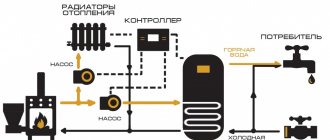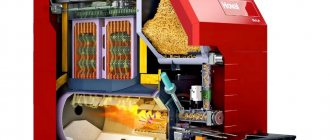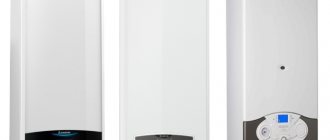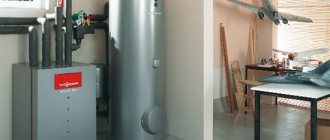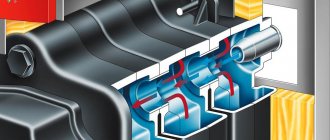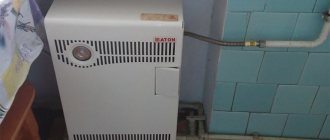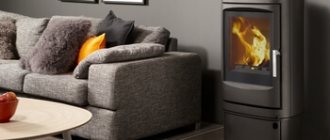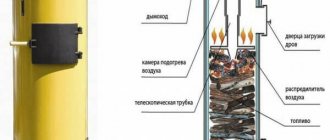“Smart” electric heating boilers can optimize the operation of equipment and reduce the cost of maintaining a comfortable temperature in the house.
The devices are safe and highly efficient. This method of organizing space heating is often the only solution in areas where there is no possibility of installing gas generators.
Electric boilers with GSM control
Electric boilers with GSM control are represented by 6 products
Electric boilers are used to heat residential and non-residential premises. Due to the high cost of electricity and high heating costs, it is necessary to use smart electronics to control heating equipment more efficiently and energy-savingly. Remote control of indoor microclimate is achieved using GSM control systems.
Check out the selection of electric boilers with GSM control and find a model that suits its characteristics.
What does GSM control provide?
Control via a cellular network makes it possible to save energy. During working hours, the temperature in the rooms can be reduced, and then increased just before arrival by giving a command from a mobile phone. Such a convenient control system will save a large amount of energy. GSM control will also notify the user about problems with the boiler and allow you to control the temperature in the rooms.
How is control carried out via GSM channel?
To access the cellular network you will need a SIM card installed in the boiler. Remote control is carried out using a smartphone with an application from the developers installed.
What is the consumption of mobile traffic?
Electric boilers with GSM control consume a limited amount of traffic - each command takes only a few kilobytes. Use for them special tariff plans with kilobyte tariffs created for smart devices.
What is the power of these boilers?
There are boilers on sale for heating rooms of various sizes - from 30 to 150 square meters. m and more. Thermal power varies from 3 to 15 kW and above.
Source
Electric boiler controlled via telephone
Climatic offers a wide range of electric boilers of various capacities. Read the information or call our consultants to choose the right boiler model.
Electric boilers are designed for heating a private house, cottage, apartment (including apartment heating)
, various administrative, commercial and industrial facilities ranging from 30 to several thousand square meters. m. Electric heating is optimal where there is no main gas or where there are strict requirements for the environmental friendliness of heating devices. Also, an electric boiler is often used as a backup heating option in case problems arise with the main boiler, for example, a gas one.
pros
: Compared to boilers using other types of fuel, electric boilers are cheaper, more compact, safe and silent. Connecting electric boilers is much simpler and less expensive than other types of boilers. Due to their compact size and light weight, electric boilers are wall-mounted, do not require a separate boiler room, and installation is allowed in utility or utility rooms, storerooms, kitchens, basements, and even in living rooms. Electric boilers are easy to operate and do not create harmful emissions or foreign odors, do not require constant maintenance, expensive cleaning or regular fuel purchases.
Minuses
: Dependence on the stable availability of electricity and high demands on the quality and reliability of electrical wiring. You should also take into account the fairly high cost of electricity. To make an informed decision about purchasing an electric boiler, it is recommended to make a preliminary calculation of electricity costs.
240 days X 8 hours a day X boiler power X cost of 1 kW of electricity
Various remote programmers that can maintain the room temperature according to a user-specified schedule help save energy without sacrificing comfort.
To select an electric boiler, you need to find out the power of the device. Basic calculation - 1 kW of boiler power is enough to heat 10 m2 of a well-insulated room with a ceiling height of up to 3 m.
To select a specific electric boiler model, you can contact the consultants of the Termomir company. Remember that in addition to the boiler itself, it is necessary to purchase other elements of a complete heating and water supply system (radiators, pipes, pumps, thermostats, boiler and much more), so it is better to entrust the selection of equipment and its complete set to professionals.
Electric energy-saving heating boilers
Units operating on AC power can be used separately or in combination with other types of installations - a wood stove, a diesel generator. In the latter case, it is optimal to use low-capacity boilers with a power of 2-5 kW. Such characteristics are sufficient to maintain the thermal balance of a house with an area of up to 120 square meters. m for 2-3 days.
Optimal results are shown by the use of electrical installations for heating a cottage or summer house, in which the owners live only during vacation or on weekends. In this case, the low cost of the products compensates for the higher maintenance costs compared to gas equipment.
Design and principle of operation of the GSM module for the boiler
In essence, the GSM module is a variation of a mobile phone, since it uses the same communication protocol.
The operating principle of the device is as follows:
The module itself consists of the following structural elements:
Operating modes
Most existing device models have two operating modes:
Some models allow you to combine modes. For example, you can enable manual control of the boiler and at the same time enable notifications about emergency situations.
How to choose a GSM module, what should you take into account?
Devices running on the Gsm platform can be purchased both in city stores and on well-known trading platforms such as Aliexpress. Before buying such a module, you should decide what capabilities are expected from it? For example, whether the length of the antenna cable to be connected is important, as well as how many telephone numbers can be used at the same time. When choosing a module, you should consider the following factors:
- number of control zones;
- availability of outputs for connecting sensors of different purposes;
- the ability to expand functionality by updating the device’s firmware;
- the presence of a relay through which feedback is provided;
ability to monitor temperature and send readings to a mobile phone
A good module has adjustable temperature modes and response thresholds.
With its help, you can remotely control the operation of the boiler and make changes to the temperature. A high-quality device will make it possible to change power indicators, and will also instantly send an SMS notification about the activation of emergency sensors.
What boilers does it work with?
Before purchasing a module, you need to find out whether the heating boiler supports the connection of such a device. Not all models have such support.
Autonomous systems with forced circulation of coolant (that is, equipped with a pump) are suitable for connecting the device. In this case, it is necessary to rework the safety system in order to prevent breakthroughs at the points where the module is connected.
Features of operation in various types of boilers
The device has specific operation in different types of heating systems:
Types of heating boilers
Autonomous heating is represented by two types of boilers, depending on the number of circuits involved.
1. A single-circuit boiler is built into an individual heating system of a residential building or industrial building. It is used only to heat a building or structure. In this case, part of the heat sometimes goes into the boiler, which heats the water in the autonomous water supply system.
2. A double-circuit boiler is used for heating and hot water supply (in flow mode). This option is often chosen for cottages, country houses and private houses, since a double-circuit boiler replaces a boiler and water heater.
Boilers also vary in performance. For one person, a boiler with a capacity of 6-8 l/min is enough, for a family of three - 8-10 l/min. To simultaneously provide water to the kitchen and shower room of a family of three, you will need a capacity of 15-20 l/min.
Another important difference between heating boilers is the operating temperature. Low-temperature boilers supply water to radiators and heated floors (40-60ºС). With this mode, a comfortable microclimate is created in the house, uniform heating is observed in all rooms with minimal energy consumption. Installations operating with this functionality are highly efficient and last a long time.
The best models of GSM modules for remote control of heating boilers
Let's look at several current device models available for purchase today.
KotelOK 2.0
A simple, inexpensive and reliable model made in Russia.
The cost of the product varies from 5,000 to 6,500 rubles. Consists of the following components:
The control panel has a wide monochrome display and four setting buttons. A good GSM antenna provides good signal quality.
The main disadvantage of the device:
The main advantage of KotelOK 2.0:
Telemetrics 3
Compact and convenient GSM module.
It has a large and most informative monochrome liquid crystal display. Control is carried out using three physical buttons located under the screen. Versatility. It can be connected not only to the boiler, but also to any other device (for example, an air conditioner).
Lack of complete outdoor antenna. Of course, third-party installation is possible. But these are additional costs. Which are completely inappropriate given the high price of the device (about 9,000 - 10,000 rubles).
Optima-1 Heat monitor
A simple, reliable and easy-to-use device.
It consists of a pair of thermostat - GSM module. Able to work with several boilers simultaneously. It is also possible to connect to an alarm system. Programming is provided for the next seven days for use in automatic mode. There is frost protection, which allows the model to be used in subzero temperatures.
Thanks to the presence of an external antenna in the kit, stable signal reception from the owner’s smartphone is ensured with almost complete absence of interruptions.
Insufficiently informative interface. There is no display here. Instead, indicator LEDs are used. It is clear that it is difficult to reflect all the necessary information with their help.
The cost of the device is from 8,500 to 9,000 rubles.
Rating of the best models
An electric boiler must demonstrate high performance characteristics, be reliable and have reduced energy consumption. The models presented in the rating received positive feedback from their owners and have proven themselves to be effective heating devices.
"Protherm Skat Ray 12KE/14"
A single-circuit boiler for wall mounting is capable of heating a room of up to 68 square meters. m. Connects to a single-phase network. Installation of an external boiler for hot water preparation is provided. The efficiency of the device is 99.5%. The control panel is equipped with an LCD display.
"Evan Next 5"
The mini-electric boiler is designed for heating a room up to 50 square meters. m. Mechanical control, 3 power levels are provided. Efficiency is 99%. There is a single-phase electric boiler and a three-phase one. The device is equipped with an overheat protection function.
Bosch Tronic Heat 3000 9
The boiler of the German company is suitable for heating a cottage or summer house with an area of up to 90 square meters. m. The product is equipped with a powerful autodiagnostic system and protective functions. Connection is possible to a 220/380 V network. Electronic control. Mounting type: wall-mounted.
Kospel EKCO.L2 12
A 12 kW single-circuit electric boiler can cope with heating a room up to 120 sq. m. m. Connects to a 380 V network. The device is designed for wall mounting. Control is electronic, there are 6 power levels. There is overheating protection, a programmer, and an auto-diagnosis function.
Also popular among users is a 15 kW electric boiler from this manufacturer, which has established itself as a high-quality and reliable unit.
"Evan EPO-18" (18 kW)
The unit is intended for heating houses, dachas, and cottages with an area of up to 180 square meters. m. The product is installed on the floor and connected to a three-phase network. Overheating protection is provided. Management is electronic.
This brand produces models of different capacities. For example, there is an 8 kW electric boiler that heats up to 75 sq.m.
"Evan WARMOS-IV-18" (18 kW)
The 18 kW single-circuit electric boiler is designed for wall mounting and is suitable for heating a house with an area of up to 180 sq. m. m. The generator efficiency is 99%. The Evan Warmos boiler operates from a 380 V mains voltage. There is an auto-diagnosis function, protection against overheating and freezing. There is a 3-stage power adjustment.
"Evan Next 9" (9 kW)
A single-circuit electric boiler for wall mounting is suitable for heating a room up to 90 square meters. m. Control – mechanical. The efficiency of the installation is 99%. The unit can be connected to a network of 220 and 380 V. There is protection against overheating and the ability to work with the “warm floor” system.
ZOTA 9 Lux
The 9 kW electric boiler is intended for wall mounting. The device can cope with heating a house or cottage with an area of up to 90 square meters. m. Operates from a 220/380 V network. There is protection against overheating and freezing, an outdoor temperature sensor, and three-stage power adjustment. It is possible to connect external control.
To heat rooms with an area of about 240 sq.m., this manufacturer produces “Zota 24 Lux” - a 24 kW single-circuit electric boiler with electronic control.
REKO-6P
A single-circuit heating system can be used to heat a room up to 60 square meters. m. It is possible to connect to a single- and three-phase network. Mounting type: wall mounted. The device is equipped with overheating protection, three-stage power control and a programmer.
This manufacturer also has other models, for example, a 30 kW electric boiler “Reco 30P”.
"RusNIT 209M"
An inexpensive 9 kW electric boiler is designed for wall mounting. Suitable for heating a room up to 90 square meters. m. Connects to 220/380 V AC mains. There is protection against overheating. Management is electronic.
The manufacturer also produces a fully automated 36 kW boiler - “RusNIT M”.
Reviews of GSM boiler control modules: advantages and disadvantages
| Advantages | Flaws |
| Remote control from anywhere in the world as long as there is a cellular signal | High, but worth the cost - on average from 4 to 7 thousand rubles |
| As a rule, several methods of management and control: SMS, application, web interface with a large set of data and statistics | The need to purchase and maintain a SIM card |
| Update data every time you connect or request | Dependence on cellular coverage and its quality; in remote country houses outside the coverage area, GSM modules are useless |
| Guaranteed autonomy and guaranteed notification of a heating system shutdown or emergency situation | A small, although sufficient selection of manufacturers and models on the Russian market |
| The ability to independently install and connect the module, having only basic knowledge (with the exception of more complex circuits using additional flow sensors, pumps, etc.) | |
| Absolutely problem-free; according to installation practice and owner reviews, the devices are durable and, as a rule, last for decades |
Smart boiler control
During operation, users experience heat losses. Their level varies depending on the time of year, day, wind speed, humidity, and insulation of the house. With increasing heat loss, there is a need for increased heat transfer from heating equipment. At the same time, sometimes there is no need to use the heating system 100%. You can control the operation of the heaters manually, or you can use automation.
The control controller receives information from sensors of room temperature, temperature of heated floors, etc. It adjusts the intensity of energy consumption depending on the subscriber’s need for thermal energy. However, conventional boilers do not respond very quickly to changing environmental conditions. The speed of the reaction depends on the degree of inertia of the system. Most conventional boilers are configured to change the return temperature. If the water temperature there decreases, a signal is sent to increase the temperature in the heater. If the return water is hot, the heater lowers the temperature.
As a rule, electric boilers use forced circulation to pump coolant. Water is pumped by a pump connected to the automation control unit. The simplest solution for a “smart” boiler is a thermostat. The consumer sets the desired temperature and the system independently regulates all processes necessary to maintain the desired temperature. Sometimes there is a timer that warms up the house before the arrival of the inhabitants.
When the set temperature is reached, the boiler turns off. However, unlike conventional systems, one or more sensors can be brought outside. Then the smart device works proactively - when the ambient temperature drops, the boiler is activated and warms up the room even before it cools down. Thus, the device operates very flexibly and adapts to environmental conditions.
The boiler can be controlled in the following ways:
1. Control module (for example, Vitotronic for gas or Logamatic for solid fuel Viessmann boilers). The functionality of such systems is represented by the following modes: “cold” (heating the coolant and hot water supply), “heat” (using only water heating), “standby” (controls the temperature, preventing the system from freezing). The control module reads information from sensors and is regulated by a thermostat.
2. Programmable thermostat (Ecobee, Tado, Honeywell). This option is suitable for those residents who are at home periodically and want to save money. The thermostat is set to certain hours and operating intensity. If there are no residents, the heating system will operate at minimum mode, and at night it will turn off everywhere except the bedrooms. Motion sensors are sometimes included with the thermostat. They activate the heating as soon as someone enters the house. In this case, the “intensive” mode is selected. This device can be controlled via Wi-Fi.
3. GSM control. This type of control is more suitable for coordinating the actions of several devices, including IR heaters, convectors and other distributed heating installations. Such systems are better suited for greenhouses, garages, small industrial premises, etc. To maintain the temperature, GSM thermometers are used, data exchange with which is carried out after sending an SMS. In the event of an emergency, the installations send an alarm message. Advanced versions of GSM controllers also report the coolant level, pressure in the system, and energy consumption.
How to choose the right model
The main criterion is the specification of the model. There are devices that are suitable only for certain models of boilers from one manufacturer; they are produced as additional equipment for the boiler; information about their purpose is usually contained in the name itself. Of course, if this is possible, it is better to choose a GSM module from the same manufacturer as the boiler (it will be tailored to a specific line of models and their specifics).
But there are also universal models that are suitable for absolutely any boiler that has the appropriate terminals; it is these universal GSM modules that are discussed in the article.
Today, the choice of universal GSM modules is small (about 20-25 models), so it is difficult to identify a sufficient number of criteria. We recommend studying the most famous and successful models (see below) and choosing from them, studying the functionality and convenience of each, comparing prices. But we also recommend paying attention to criteria such as:
The best known manufacturers and models: characteristics and prices
"Kotel OK"
The most popular on the market, one of the best and most inexpensive GSM modules for heating boilers made in Russia. In addition to the price, it is distinguished by its compact size, extremely simple and easy setup, and the presence of an application that can send commands, including in the form of SMS, which is an excellent option that allows you not to use tariffs with Internet access.
The functionality of the device is quite simple, the minimum required: temperature control, setting alerts, checking boiler operating parameters, and the module also has a built-in relay that allows you to turn the boiler on and off.
Among the disadvantages, it is worth noting a rather simple application with the minimum required functionality and an outdated interface, the presence of an external temperature sensor with a cable length of only 0.5 meters, which does not imply its installation in other rooms remote from the boiler room. The antenna is also not remote, screwed into the device via a threaded connection.
XITAL GSM 4T
Another well-known, more professional and versatile device with a much richer package. The heating control functionality in it is approximately the same as in the previous “Boiler OK” - the minimum required, however, there are as many as 4 zones for additional devices (flow sensor, smoke sensor, motion sensor, flood sensor, door opening sensor, etc.). Also included is an electronic key and a reader (similar to those installed in intercoms), so you can influence the settings, if desired, only with an electronic key.
Electric boilers with GSM module controlled from a phone, via the Internet.
One of the most interesting and convenient types of controlling the heating system in your country house or dacha is setting the boiler parameters via the Internet, using a GSM module. Regardless of what city you are in, you can always find out and reconfigure almost all temperature indicators of the heating system.
EVAN electric boilers with GSM module
There are no models in the EVAN product line of electric heating boilers that already have this automation installed as standard. First of all, this decision is caused by the impossibility of imposing an additional option on customers. which they may not need. But you can install such automation in any, even the most inexpensive EVAN electric boiler:

